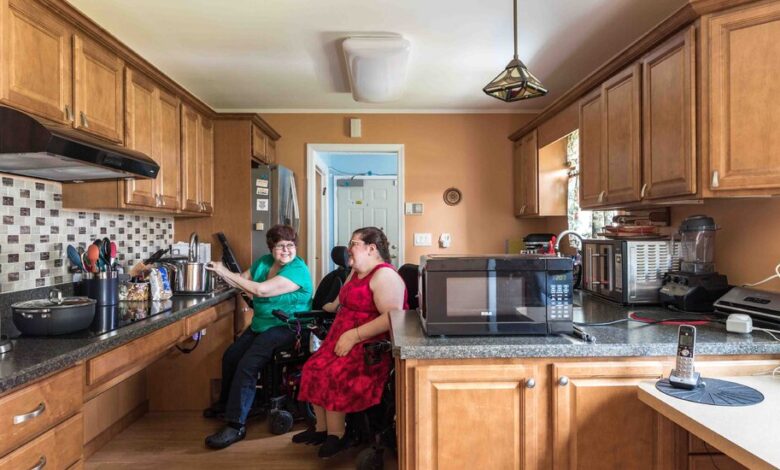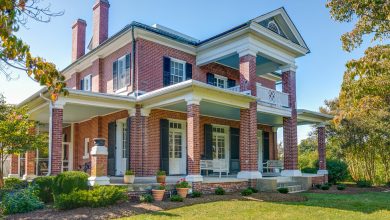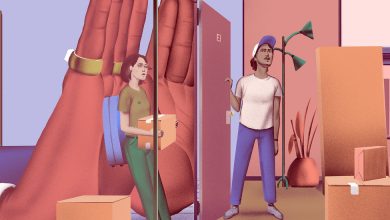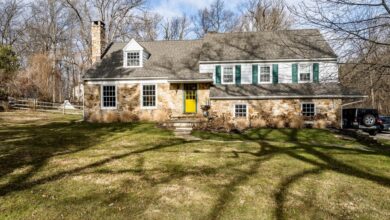How to Make Your Home Accessible

[ad_1]
Tatiana Martinez needed an accessible home. Her then 7-year-old son, who uses a wheelchair, was too heavy to carry upstairs to his second-floor bedroom.
“I constrained my home search to within a few towns from where I was already living because I wanted to remain with the same school services for my son,” said Ms. Martinez, a resident of Union County, N.J.
After her three-year search, Ms. Martinez bought a one-story home near Summit, N.J., in 2019 for $900,000. Then she installed a lift at the front entrance of the house, ramps to access the backyard, modified the bathroom to be compliant with the Americans with Disabilities Act, and widened several doorways. The modifications cost $50,000.
Stories like Ms. Martinez’s are playing out in millions of households in the United States. The 2019 American Housing Survey data shows that 12.9 percent, or 16 million of the total households in the United States, include at least one person who uses a wheelchair, walker, or other mobility device. Of those 16 million households, at least 3.5 million plan to improve the accessibility of their homes.
There are resources available from some state governments, nonprofit groups, housing groups and developers that can be used to make homes safe for family members of all abilities.
Accessible Solutions
Home styles vary greatly from state to state. Accessible homes may be easier to find in some parts of the country than others. For example, ranches are easier to find in the south and west. In the Northeast, two story homes are more common. The good news is that whether you choose to remain in your current home, or move and then modify, there are many opportunities to make a home more accessible.
“Ramps, lifts and regrading are all options that an expert can gauge with a home assessment,” said Gregg Frank, owner of Back Home Safely, a modification company based in New Jersey.
Tucker Cassidy of Waterloo, Iowa, moved because he needed to live in an area with a larger pool of home health aides. He scanned real estate listings, Craigslist and even roommate ads until he found a home that fit his needs with a “bedroom big enough for my power chair, shower chair, a Hoyer lift, an adjustable bed and storage for medical equipment,” Mr. Cassidy said. Then, he widened several doorways and added a concrete ramp to both the front and back entrance.
“Each type of modification is dependent on individual’s mobility needs and what works best for that particular style of home,” said Eric Rubel, director of marketing at Lifeway Mobility, a company that addresses individual accessibility problems throughout the country. “For example, an entrance with a few steps could be better suited by adding a wheelchair ramp. Wheelchair ramps are often the quickest and most economical solution for low-rise entrances. However, if space is limited, a wheelchair lift, OR stairlift, may be the only solution to provide safe access. Other things to consider when looking for accessibility are few to no stairs, a flush entryway, no level changes at thresholds, wide doorways and barrier-free showers.”
To find a local modification expert, contact the National Association of Home Builders (NAHB), where Certified Aging-in-Place Specialists (CAPS) can help evaluate a home for accessibility opportunities. Occupational therapists who have a certification in environmental modification can be found through the American Occupational Therapy Association (AOTA) and can help tailor a home specifically for an individual or family’s needs.
“Modifications should be client-centric,” said Carolyn Sithong, an occupational therapist and founder of Home for Life Design, a web-based home assessment solution for healthcare professionals. “They should be driven by the person and the person’s ability.”
Costs and Financial Support
Jennifer Boyle and her husband Neil bought a ranch-style home in Essex County, N.J., for their son, Sean who is 19 and uses a wheelchair, and modified the entry. The house “had stairs from the driveway to the walkway, and another set of stairs at the front door,” Ms. Boyle said. “We regraded our yard and added to our driveway which allowed us to park close to our front door and roll my son’s wheelchair right into the house.”
The cost to regrade their home was $33,000 and they received reimbursement of $25,000 from the New Jersey Catastrophic Illness in Children Relief Fund. This program reimburses families for expenses related to their child’s medical condition, including home modifications, if their expenses exceed a certain percentage of their income.
“Reimbursement is not guaranteed, but the fund may consider all expenses related to a child’s condition in a 12-month period,” said Christian Heiss, executive director of the New Jersey fund. If the qualifications are met, residents can receive $25,000 toward home modification costs per year.
Massachusetts also has a Catastrophic Illness in Children Relief Fund Program. To find out if similar programs exist in your state, contact your state’s department of human services.
Adiba Nelson of Tucson, Ariz., was able to modify her bathroom when her daughter, Emory Webster, was 10 years old and began navigating her power wheelchair on her own.
“The house was a one-story home that was mostly accessible already. It didn’t have thresholds or carpet and had an open floor plan, sizable rooms and doorways. The pantry with low shelves made it easy for my daughter to grab snacks. We modified the bathroom by removing the tub and replacing it with a roll-in shower,” Ms. Nelson said.
She received funding through the Arizona Division of Developmental Disabilities for the bathroom modification, which she guesses cost around $15,000, although the division paid for it directly.
Medicaid and other programs vary by state, but Mr. Rubel, of Lifeway Mobility, suggests clients who may need financial support to look into various state or nonprofit programs. Certain home improvements made that are medically necessary to care for a person with a disability are potentially tax deductible as an itemized deduction,” said Ray Hough of Graceffo, Hough & Weintraub, an accounting firm in Glen Rock, N.J., such as “constructing entrance or exit ramps for your home, widening doorways at entrances or exits to your home or widening or otherwise modifying hallways and interior doorways.”
A few years after modifying her home, Ms. Nelson separated from her husband and looked for a rental. She eventually found a “two story townhouse with a first-floor bedroom,” Ms. Nelson said. “My daughter is on the first floor and I’m on the second floor. We like having our own space.”
Individuals who rent may need to pay more attention to accessibility because it is unlikely they will be able to make permanent modifications.
According to the Fair Housing Act, which protects both renters and buyers in the housing market, it is “unlawful to refuse to make reasonable accommodations to rules, policies, practices, or services when such accommodations may be necessary to afford people with disabilities an equal opportunity to use and enjoy a dwelling and public and common use areas.”
Under the Fair Housing Act, renters generally need approval from the landlord, must pay for modifications and return the residence to its original design, said Glen H. Parker, a disability rights attorney in New York. Some states and cities provide more rights to renters, requiring landords to pay for modifications, he said.
The least permanent option and fastest way to make a house accessible from the outside is to add an aluminum ramp. An aluminum ramp is portable and can often be put in place in one day. “Ramp cost is based on length,” said Mr. Frank, owner of Back Home Safely. “For every inch of rise in the steps, you need about one foot of ramp. Three eight-inch steps would require the ramp to be 24 feet long and a foot of ramp costs around $150 so, to purchase a ramp to cover a three-step entrance would be around $3,600. Rentals are also available.”
Ellen Ladau and her daughter, Emily are both power wheelchair users in Suffolk County, Long Island. Ms. Ladau modified their bathroom by adding a roll-in shower and sink. She was able to get funding through Medicaid to pay for it, but the first modification didn’t work out because the wheelchair turning radius wasn’t wide enough.
“Finding the right person to do the evaluation matters,” said Ed Myers, associate professor of occupational therapy at Florida Gulf Coast University in Fort Myers. “Ask the right questions and make sure the evaluator looks at the whole person, the family and what activities are important in their daily lives.”
One modification to a home might not be sufficient for most people with disabilities.
Ms. Ladau ended up modifying their bathroom a second time. Now, she’s slowly making adjustments to the kitchen to make it more functional. For example, she moved her dishes and bowls to a lower cabinet, so it was easier to empty the dishwasher.
“It’s not an overnight fix,” Ms. Ladau said. “The needs of a person can evolve and change over time. The modifications that you make at a certain juncture might not work as you age.”
Accessibility for All
In the future, universal design, or homes built from the ground up with open floor plans, no-step entry and that are barrier-free, can allow for any and all individuals, regardless of ability, to enjoy the amenities of a home.
But aside from simple designs, cost is also a factor that Micaela Connery, co-founder and chief executive of The Kelsey, a nonprofit based in the San Francisco Bay Area, is concerned about. The Kelsey works with housing developers all over the country to create accessible homes.
These developers are either proactively looking to include designs that consider the disabled within the populations they are serving, or they’re working in places where accessibility and inclusion of people with disabilities is incentivized or required. Income restrictions for the housing might apply.
“We want to design better housing for all people by focusing on affordability, accessibility and inclusivity,” Ms. Connery said.
Their designs, which typically include communities of 100 or more housing units, are not only accessible and affordable, but are often near public transit. This gives wheelchair users and other people with disabilities easy access to public transportation allowing them to work, enjoy communities and be closer to family, friends and other necessary resources.
“If it’s too tiring to get ready in the morning, you aren’t going to go out,” Dr. Myers said. “Personal accessibility starts with the human being.”
[ad_2]
Source link






